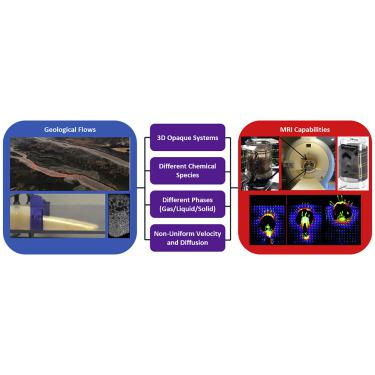iScience ( IF 5.8 ) Pub Date : 2020-09-05 , DOI: 10.1016/j.isci.2020.101534 Einat Lev , Christopher M. Boyce

|
Geological flows—from mudslides to volcanic eruptions—are often opaque and consist of multiple interacting phases. Scaled laboratory geological experiments using analog materials have often been limited to optical imaging of flow exteriors or ex situ measurements. Geological flows often include internal phase transitions and chemical reactions that are difficult to image externally. Thus, many physical mechanisms underlying geological flows remain unknown, hindering model development. We propose using magnetic resonance imaging (MRI) to enhance geosciences via non-invasive, in situ measurements of 3D flows. MRI is currently used to characterize the interior dynamics of multiphase flows, distinguishing between different chemical species as well as gas, liquid, and solid phases, while quantitatively measuring concentration, velocity, and diffusion fields. This perspective describes the potential of MRI techniques to image dynamics within scaled geological flow experiments and the potential of technique development for geological samples to be transferred to other disciplines utilizing MRI.
中文翻译:

利用磁共振成像表征地质流的机会
从泥石流到火山喷发的地质流通常是不透明的,由多个相互作用阶段组成。使用模拟材料的大规模实验室地质实验通常仅限于流动外部的光学成像或异位测量。地质流通常包括内部相变和化学反应,很难从外部成像。因此,地质流背后的许多物理机制仍然是未知的,从而阻碍了模型的发展。我们建议使用磁共振成像(MRI)通过非侵入性的原位增强地球科学3D流量的测量。MRI当前用于表征多相流的内部动力学,区分不同的化学物质以及气相,液相和固相,同时定量测量浓度,速度和扩散场。该观点描述了MRI技术在成比例的地质流动实验中对动态成像的潜力,以及将地质样品转移到其他使用MRI的学科中的技术潜力。



























 京公网安备 11010802027423号
京公网安备 11010802027423号